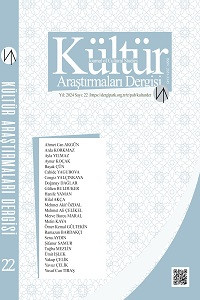Öz
The information obtained about stones in the Islamic civilization was transferred to people, sometimes through translation and sometimes through copyrighted works. The first stone-specific works in the Ottoman Empire began to be seen through translation in the 15th century. The information explained in these works, which have an important place in the tradition of classical Turkish literature, has also been included as a special section in different encyclopedic works. One of the works of this type is the encyclopedic work named Tezkiretü'l-Acâyib and Tercemetü'l-Garâyib by Eyyûb bin Halîl (b.? –d. after 1570), who lived in the 16th century. In this work, the translator gives information about thirty-four stones. The work describes the colors of these stones, their regions and their properties. It is noteworthy that this information is conveyed from Kitâbü’l-Ahcâr, which is generally attributed to Aristotle. In addition, the works of important scientists such as Avicenna, Galinos and Belinas were also benefited from. The information provided by the work, which has a single and unfinished copy, shows the knowledge, culture and language understanding of the period. In the first part of this study, Eyyûb b. Halîl and his work were examined in the second part by listing the stones in the work in their order.
Anahtar Kelimeler
Ayyub bin Khalil stones mineralogy Acâyibü’l-Mahlukât translated works
Kaynakça
- Ak, Mahmut (2007). Âşık Mehmed Menâzırü’l-Avâlim I-II-III. Ankara: Türk Tarih Kurumu Yayınları.
- Aksoy, Gürsel (2021). Aristoteles’in Taşlar Kitabı; Kitâbu’l-Ahcâr li-Aristâtâlîs (İnceleme-Arapça Metin-Çeviri-Yorum). İstanbul: Büyüyen Ay Yayınları.
- Argunşah, Mustafa (1990). “15. Yüzyılda Yazılmış Tuhfe-i Murâdî İsimli Cevhernâmede Geçen Değerli Taşlarla İlgili Terimler”. Türklük Araştırmaları Dergisi, 6: 1-20.
- Argunşah, Mustafa (1999). Muhammed b. Mahmûd-ı Şirvânî Tuhfe-i Murâdî, İnceleme-Metin-Dizin. Ankara: TDK Yayınları.
- Aydın, Mükerrem Bedizel ve Murad, Sibel (2019). Nizâmü’l-Edviye, Sakızlı İsa Efendi. Ankara: TÜBA.
- Bardakçı, Ramazan ve Tıraş Yusuf Can (2023). “Eyyûb bin Halîl’in Acâyibü’l-Mahlûkât Tercümesi: Tezkiretü’l-Acâyib ve Tercemetü’l-Garâyib”. Akademik Dil ve Edebiyat Dergisi, 7(3): 2438-2462.
- Eyyûb b. Halîl, Tezkiretü’l-Acâyib ve Tercemetü’l-Garâyib, Eyyûb b. Halîl Avusturya Milli Kütüphanesi, G. Flügel, II, 508, nr. 1440.
- Murad, Sibel (2019). Cevher-nâme-i Sultan Murâdî (İnceleme-Tenkitli Metin-Dizin-Tıpkıbasım). İstanbul: DBY Yayınları.
- Murad, Sibel (2023). Muhammed b. Garsüddîn El-Halebî Cevher-nâme [İnceleme - Sadeleştirilmiş Metin-Tıpkıbasım/Çevriyazılı Metin-Dizin. İstanbul: DBY Yayınları.
- Murad, Sibel ve Ateş, Büşra (2018). "Muhammed b. Garsü’d-dîn El-Halebî’nin Cevher-Nâme’si”. Amasya Üniversitesi Sosyal Bilimler Dergisi, 2(3): 97-116.
- Özcan, Emine Sonnur (2020). Kıymetli Taşlar ve Metaller Kitabı (el-Cemâhir Fî Ma’rifeti’l-Cevâhir). Ankara: TTK Yayınları.
Öz
İslam medeniyetinde taşlar hakkında edinilen bilgiler, kimi zaman tercüme kimi zaman da telif eserlerle insanlara aktarılmıştır. Osmanlı Devleti’nde taşlara özgü ilk eserler 15. yüzyılda tercüme yoluyla görülmeye başlanmıştır. Klasik Türk edebiyatı geleneğinde önemli bir yeri olan bu eserlerde anlatılan bilgiler, farklı ansiklopedik eserlerde özel bir bölüm olarak da yer almıştır. Bu türde olan eserlerden biri de 16. yüzyılda yaşamış olan Eyyûb bin Halîl’in (d. ?–ö. 1570’den sonra) Tezkiretü’l-Acâyib ve Tercemetü’l-Garâyib adlı ansiklopedik eseridir. Bu eserde mütercim, otuz dört taş hakkında bilgi vermektedir. Eserde bu taşların renkleri, bulundukları bölgeler ve özellikleri anlatılmaktadır. Bu bilgilerin genellikle Aristoteles’e atfedilen Kitâbü’l-Ahcâr’dan aktarıldıkları göze çarpmaktadır. Ayrıca İbn Sînâ, Galinos, Belinas gibi önemli ilim insanlarının eserlerinden de faydalanılmıştır. Tek ve yarım kalmış bir nüshası bulunan eserin vermiş olduğu bilgiler dönemin bilgi, kültür ve dil anlayışını göstermektedir. Bu çalışmanın birinci bölümünde Eyyûb b. Halîl ve eseri, ikinci bölümünde eserdeki taşlar yer aldığı sıraya göre verilerek incelenmiştir.
Anahtar Kelimeler
Eyyûb bin Halîl taşlar mineraloji Acâyibü’l-Mahlûkât tercüme eser
Kaynakça
- Ak, Mahmut (2007). Âşık Mehmed Menâzırü’l-Avâlim I-II-III. Ankara: Türk Tarih Kurumu Yayınları.
- Aksoy, Gürsel (2021). Aristoteles’in Taşlar Kitabı; Kitâbu’l-Ahcâr li-Aristâtâlîs (İnceleme-Arapça Metin-Çeviri-Yorum). İstanbul: Büyüyen Ay Yayınları.
- Argunşah, Mustafa (1990). “15. Yüzyılda Yazılmış Tuhfe-i Murâdî İsimli Cevhernâmede Geçen Değerli Taşlarla İlgili Terimler”. Türklük Araştırmaları Dergisi, 6: 1-20.
- Argunşah, Mustafa (1999). Muhammed b. Mahmûd-ı Şirvânî Tuhfe-i Murâdî, İnceleme-Metin-Dizin. Ankara: TDK Yayınları.
- Aydın, Mükerrem Bedizel ve Murad, Sibel (2019). Nizâmü’l-Edviye, Sakızlı İsa Efendi. Ankara: TÜBA.
- Bardakçı, Ramazan ve Tıraş Yusuf Can (2023). “Eyyûb bin Halîl’in Acâyibü’l-Mahlûkât Tercümesi: Tezkiretü’l-Acâyib ve Tercemetü’l-Garâyib”. Akademik Dil ve Edebiyat Dergisi, 7(3): 2438-2462.
- Eyyûb b. Halîl, Tezkiretü’l-Acâyib ve Tercemetü’l-Garâyib, Eyyûb b. Halîl Avusturya Milli Kütüphanesi, G. Flügel, II, 508, nr. 1440.
- Murad, Sibel (2019). Cevher-nâme-i Sultan Murâdî (İnceleme-Tenkitli Metin-Dizin-Tıpkıbasım). İstanbul: DBY Yayınları.
- Murad, Sibel (2023). Muhammed b. Garsüddîn El-Halebî Cevher-nâme [İnceleme - Sadeleştirilmiş Metin-Tıpkıbasım/Çevriyazılı Metin-Dizin. İstanbul: DBY Yayınları.
- Murad, Sibel ve Ateş, Büşra (2018). "Muhammed b. Garsü’d-dîn El-Halebî’nin Cevher-Nâme’si”. Amasya Üniversitesi Sosyal Bilimler Dergisi, 2(3): 97-116.
- Özcan, Emine Sonnur (2020). Kıymetli Taşlar ve Metaller Kitabı (el-Cemâhir Fî Ma’rifeti’l-Cevâhir). Ankara: TTK Yayınları.
Ayrıntılar
| Birincil Dil | Türkçe |
|---|---|
| Konular | Osmanlı Sahası Klasik Türk Edebiyatı |
| Bölüm | Araştırma Makaleleri |
| Yazarlar | |
| Yayımlanma Tarihi | 10 Eylül 2024 |
| Gönderilme Tarihi | 18 Mayıs 2024 |
| Kabul Tarihi | 7 Temmuz 2024 |
| Yayımlandığı Sayı | Yıl 2024 Sayı: 22 |


